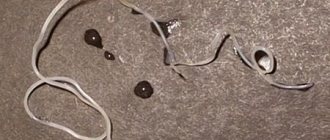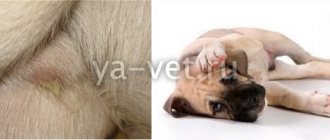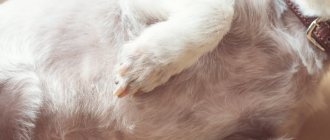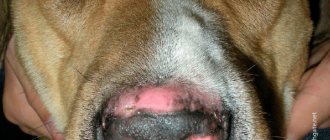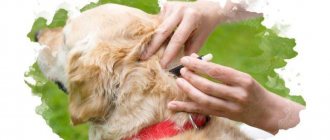Dogs, due to their activity and busy lives, are susceptible to skin diseases, among which is eczema. This term refers to inflammation of the outer layers, on which signs of inflammation with rashes appear. Good prevention will help prevent such consequences - in our clinic we carry out a thorough examination of pets, ultrasonic cleaning of animals’ teeth and other procedures. The main thing is to visit the doctor on time.
Eczema begins in the superficial epidermis and spreads to the deeper layers. When prolonged, it causes serious damage, which can lead to infection. It is not recommended to treat this pathology on your own; urgent consultation with a veterinarian is necessary. To do this, you should know the types of eczema and the characteristics of its clinical manifestations.
What is eczema in dogs: explanations and photos
Eczema is a type of inflammation that occurs on the epidermis (outer layer of skin) and gradually spreads to deeper layers. Dog hair masks the lesion for a long time, preventing its detection at the initial stage. Despite this, inflammation always occurs due to internal and external irritants, which means it can be prevented.
The inflammatory process is accompanied by the appearance of ulcers, roseola (rash), papules or vesicles (bubbles with liquid). Depending on the number of rashes, eczema can be monomorphic (only one type) and polymorphic (several types at the same time).
General information
Dermatitis is an acute inflammatory process of the skin , caused by various unfavorable factors, such as allergies, pathogens, stress, burns , etc. The most common signs of this disease are rash, itching, redness, blisters and crusts. In general, weeping dermatitis develops in the same way, but in the process the affected area begins to ooze ichor or exudate.
It gets wet, which creates excellent conditions for the development of pathogenic and conditionally pathogenic microflora. That is why almost all cases of weeping dermatitis are accompanied by the appearance of an unpleasant and even disgusting odor , as well as symptoms of general intoxication.
Forms of the disease
In addition to the number of rashes, several other factors are taken into account when classifying the disease. These include the nature and duration of the course, as well as the cause of its occurrence.
Dry and weeping
According to the nature of the course, eczema in dogs can be dry and wet (weeping). In the first case, the skin at the site of the lesion becomes dry and flaky, and dandruff appears. In the second case, the inflamed surface becomes moist and shiny, and purulent crusts form along the edges of the wound.
Acute or chronic
Depending on the duration of the disease, it can be acute or chronic. In the first case, clear clinical signs are observed that worsen the animal’s quality of life, and in the second case, alternating remissions and relapses are observed. The chronic type is difficult to treat, so inflammation remains on the body from several years until the end of life.
Classification by origin
Depending on the origin, there are 3 forms of the disease. These include:
- Reflex
. Develops due to external and internal influences. The former include ectoparasites, toxic substances and dirt, the latter – diseases of internal organs, helminthiases and allergies. Allergic eczema in dogs provokes the development of a dry form, but when bacteria penetrate the affected area, it can develop into a wet form.
- Traumatic
. It occurs as a reaction to any type of injury (bites, abrasions, burns, blows) left without timely treatment. Provokes the development of a weeping form.
- Neuropathic
. The rarest form, resulting from a vegetative disorder. Lesions are symmetrical and can combine dry and wet forms.
In addition to the main reasons listed in the classification, there are a number of factors that provoke the appearance of skin rashes. Most often, older dogs with low immunity and breeds with folded skin suffer from the disease.
Therapeutic techniques
Let us immediately describe the main provisions of all therapeutic methods actively used in the treatment of this disease:
- It is necessary to completely get rid of the irritating factor and protect the pet from the action of the identified allergen (only a doctor can determine it in an equipped clinic).
- Treatment of damaged dermatitis with chlorhexidine. This is a good and inexpensive antiseptic that will help prevent bacterial contamination.
- The use of antibacterial drugs, of which the most accessible to the “mere mortal” is the usual chloramphenicol.
- To relieve skin itching, it is necessary to use antihistamines. If the dog is completely unbearable, the pet is literally tearing the skin, you can use half a tablet of Suprastin. But it’s better to take your pet to the vet right away.
- Nutritional adjustments are required. Again, we strongly advise you to talk to your veterinarian for this.
- If there is a sharp deterioration in the condition of the skin, it is necessary to urgently contact a veterinary dermatologist or allergist.
Causes of eczema in dogs
Sometimes completely harmless factors can act as provocateurs. A skin reaction may occur to new food, incorrectly selected shampoo, dust or a dirty bed. The most common causes of skin inflammation include:
- low-quality and allergenic products;
- weak immune system and increased susceptibility to allergic reactions;
- prolonged accumulation of moisture in skin folds;
- exposure to alkalis and acids;
- hormonal disorders and the presence of chronic diseases;
- poor hygiene and insufficient animal care;
- excessive or insufficient production of fatty secretions;
- prolonged stress;
- swimming in polluted waters;
- overheating and hypothermia.
In pets with shaggy and thick hair that fits tightly to the body, it is almost impossible to determine the disease at the initial stage. For this reason, veterinarians recommend regularly inspecting your pet's skin for lesions after every walk.
Particular attention should be paid to at-risk breeds: Shar Peis, Pugs, Bloodhounds, Mastiffs, English Bulldogs and Basset Hounds.
Recommendations for caring for a sick pet
Personal hygiene is mandatory in case of infectious diseases, along with patient isolation. Immediately after contact with a sick animal, it is necessary to use disinfectants; it is possible to take vitamins and antifungal drugs.
Regular wet cleaning of the premises is necessary. Items that the pet has come into contact with should be disposed of whenever possible.
The diet should be balanced; the benefits of vitamins have already been mentioned above. It is advisable to confirm the diet with your doctor.
Be sure to follow all veterinarian instructions and monitor your sick pet.
Course and development of pathology
The beginning of the development of pathology is erythema - swollen redness of the surface layer of the skin. It occurs due to scratching caused by severe itching. Over time, papules appear on its surface - small tubercles that are gradually filled with liquid contents. After filling the voids and increasing in size, the resulting papules transform into vesicles. At this stage, the disease occurs in 2 scenarios:
- Dry form
. The liquid in the bubbles gradually dissolves, so the surface remains dry. Dried papules become crusty and peel off. For this reason, dandruff and flaking occur at the affected area.
- Wetting form
. The contents of the vesicles darken. Bursting blisters spread pus over the surface, inflaming neighboring areas and provoking the development of extensive weeping ulcers.
The rate of development of the disease is individual for each animal. Some stages occur so quickly that they cannot be detected without the help of laboratory diagnostics.
Treatment at home - traditional methods
We present traditional medicine recipes for your reference and remind you that all of them do not have proven effectiveness. In addition, uncontrolled use of these products without the advice of a veterinarian can harm your pet. Be careful and attentive!
First method
What you will need:
- disposable medical gloves;
- laundry soap;
- cotton pads;
- iodine.
How to process:
- put on gloves and carefully trim the hair in areas affected by lichen;
- Make a saturated soap solution from laundry soap and warm water;
- treat sore areas with cotton pads, being careful not to hurt the dog;
- After this, treat the affected areas with iodine.
The procedure is repeated daily until the animal recovers. To prevent your dog from licking its wounds, use an Elizabethan collar.
Important!
Remember that iodine is toxic to animals, do not overuse self-medication!
Second method
What you will need:
- disposable medical gloves;
- cotton pads;
- Apple vinegar.
How to process:
- put on disposable gloves and trim the hair around the wounds;
- soak a cotton pad in apple cider vinegar and treat the affected areas;
- repeat the treatment daily until the shingles go away.
This method is only suitable for pityriasis rosea. Other types of pathology are not treated in this way.
Important!
If traditional medicine does not help, be sure to show your pet to a veterinarian, he will tell you how to treat lichen in dogs.
Video
Symptoms in different forms
The first symptom of the disease is restless behavior caused by severe itching. The animal constantly itches, gnawing into the affected area with its teeth. At this stage, the owner may notice erythema.
Symptoms and treatment for weeping and dry eczema in dogs are different. In the first case, symptoms are accompanied by:
- pain (the pet does not allow you to touch the affected areas and whines while scratching);
- moisturizing the skin surface;
- chills and fever;
- loss of appetite and severe weight loss;
- apathy, nervousness and sleep disturbances;
- bowel disorder.
At the site of wet ulcers, focal alopecia is noted. Wounds appear with ichor flowing out, which sticks the fur together. Foci of inflammation gradually merge, increasing the affected area.
The dry type of pathology is accompanied by more severe itching in the absence of pain. In areas of peeling, the hair stands on end and thins out a little, and then begins to fall out in clumps. Dandruff and seborrheic plaques form on the problem area. Most often the sternum, back and withers are affected.
Prevention
Anyone can experience skin diseases in their pet. Even the most correct, thorough care will not be able to exclude the possibility of recurrent disease. Prevention helps to significantly reduce the risk of eczema in dogs. Here are the main preventive methods:
- the animal's diet must be balanced and complete;
- The dog should receive a complex of essential vitamins and microelements with food;
- the pet should receive fats that help improve skin and proteins that affect cell renewal and restoration;
- It is necessary to dry the animal's fur well after swimming in the summer;
- for bathing, use only shampoos with neutral pH;
- You should protect your dog from injury, as traumatic eczema in dogs can occur at the site of damage to the skin;
- the animal should not be allowed to come into contact with household chemicals, acids, mineral fertilizers, especially during the summer season;
- The dog should not be in a state of stress; it should not be shouted at or constantly scolded.
The owner must always remember that the best prevention is attention and care. If the animal is already sick, proper care of the pet, compliance with all doctor’s recommendations and timely medical care are of great importance.
Currently reading:
- The most common skin diseases in dogs
- Thyroid dysfunction in dogs (hypothyroidism)
- Games to choose for training a dog
- Seven Signs and Remedies for Getting Rid of Fleas in Dogs
Is canine eczema contagious?
The disease is not contagious to humans or other domestic animals. Despite this, it is recommended to follow basic precautions when treating wounds: wash your hands and wear protective gloves. Otherwise, pus containing bacteria or fungi can get onto the damaged surface of human skin and cause an inflammatory process in the owner. This situation is unlikely, but quite possible.
What should be done to eliminate weeping dermatitis?
First, you need to carefully cut and shave (if possible) the hair around the areas of inflammation. This makes it much easier to clean the surface from dried crusts of exudate, and the application of medications is simplified. It is recommended to use Nolvasan to wash inflamed areas of the skin, but chlorhexidine also cleans everything well. To achieve drying of constantly weeping foci of inflammation, use medicinal powders (you can use simple streptocide powder).
In severe cases, before performing these manipulations, the animal must be administered powerful sedatives , otherwise your pet will be in great pain. As a rule, broad-spectrum antibiotics Most likely, in the first week or two you will have to regularly give your pet sedatives and painkillers. By the way! Never use medications used to relieve pain in a person. The same “Nurofen” for dogs is still poison (aspirin, by the way, is even worse).
How to diagnose
To fix the problem, you need to find out its exact cause. For this purpose, during the examination, the veterinarian must take a blood test, skin scraping and ultrasound of the internal organs from the four-legged patient. If parasites are suspected, stool and urine tests may be required.
How and with what to treat eczema in a dog
Complex treatment involves combining external treatment of wounds and ulcers with internal medication. It is selected individually, taking into account the age of the animal, the type and cause of the pathology.
Medicines, ointments and sprays
If there is copious discharge of serous or purulent fluid, infusion therapy (droppers) with sodium bromide, calcium chloride or sodium hyposulfite is carried out. If abnormalities in the liver are detected, hepatoprotectors are prescribed without fail. Severe anemia is eliminated with blood transfusions and immunomodulators.
The choice of medications depends on the form of pathology:
- Dry
. Treat with glucocorticosteroids (Dermozolon, Fluorocort, Cortomycetin) and antihistamines (Suprastin, Diphenhydramine). The skin is moisturized with special shampoos, gels, ointments and sprays. When choosing a product, it is important to combine an anti-inflammatory and antibacterial effect to avoid secondary infection.
- getting wet
. Eliminate with antibiotics (Sinulox, Erythromycin), which are used in combination with sorbents. To treat wounds, tar soap, Lassar paste, Salicylic acid and Terramycin spray are used, which help restore the skin and protect against re-infection.
Pain is relieved with painkillers and novocaine blockade. To relieve stress, sedatives with a calming effect are prescribed. For the entire duration of treatment, the pet must wear a protective collar to prevent licking of ointments and scratching of wounds.
Eliminate the root cause
After identifying the cause of the disease, it is necessary to eliminate it. To do this you will have to:
- treat the animal for external or internal parasites;
- regularly carry out not only dry, but also wet cleaning, paying special attention to the sleeping area and feeding troughs;
- take care to create a comfortable environment in the house, eliminating dampness, cold and too high temperatures;
- protect your pet from exposure to ultraviolet radiation and direct sunlight;
- change care products by choosing veterinary hypoallergenic products;
- refuse aggressive household chemicals;
- Change a collar or harness that causes contact damage.
Additionally, the dog is prescribed therapeutic diets and special procedures. It is necessary to care for the affected skin on the paws, abdomen, ears and other affected areas until the skin is completely restored.
Diet and care
To regenerate the skin, foods containing large amounts of sulfur, cobalt and zinc are introduced into the diet. Amino acids include methionine and cysteine. Meat and offal are temporarily limited, with an emphasis on dairy and plant foods.
After carefully cutting off the fur, the areas of inflammation are treated with special sterile wipes, and the dried crusts are soaked with chlorhexidine. Additionally, the surface is treated with ichthyol, zinc or xeromorphic ointments that absorb seals. Among folk remedies, it is permissible to use freshly squeezed plantain juice, honey, decoctions of celandine, nettle, burdock and string. All medications are prescribed by a veterinarian.
Duration of treatment
The treatment period takes from 2 weeks to several months. The duration depends on the severity of the pathology and compliance with medical recommendations. If the owner stops care immediately after the first improvements, then in the future the disease may worsen and become chronic.
The best drugs
The following groups of drugs are used to treat eczema:
- desensitizing;
- anti-inflammatory;
- antipruritic;
- wound healing;
- restorative.
To relieve sensitization, eliminate itching and stop the inflammatory process, the veterinarian prescribes the following medications:
- Apoquel : tablets relieve itching and help reduce the affected area. The dog does not comb itself, infection of the skin by secondary microflora is prevented. Tablets are taken twice a day as prescribed by a doctor, but not more than 14 days. For recurrent atopic dermatitis, Apoquel is used to prevent exacerbation. The cost of the package is 2500 rubles/20 tablets.
- Cortavance - aerosol: anti-inflammatory hormonal agent. Spray from a distance of 10 centimeters. Pressing the wound spray head is enough to treat a lesion with an area of \u200b\u200b1 cm2. Once for 7 days in a row. The cost of a bottle of 76 ml is 2700 rubles.
- Stop-itch suspension contains glucocorticoid, succinic acid, methionine, and vitamins. The liquid is injected into the mouth once, using a dispenser syringe or with a treat. The course of treatment is 12 days. The cost of a 10 ml bottle is 300 rubles.
- Stop-itch spray includes a hormonal component, an anesthetic, the antibiotic chloramphenicol, and the antiprotozoal drug Metronidazole. The developer recommends treating the affected areas 2 times a day until recovery. If after ten days of use the expected effect does not occur, the drug is discontinued. The cost of a 30 ml bottle is 400 rubles.
- Lecaderm ointment includes the antiseptic Gentamicin, the antimycotic Clotrimazole, and the anti-inflammatory corticosteroid Bentamethasone. The cream eliminates itching and stops the inflammatory process. The ointment is applied to skin cleansed from scabs 1 or 2 times a day, 7-14 days in a row. The cost of a 15 g tube is 450 rubles.
- Chemi spray contains the antibiotic chlortetracycline and the fungicide gentian violet. The drug is prescribed for the treatment of interdigital eczema. Treat affected areas outdoors, as gentian violet leaves purple marks on furniture. The damaged surface is freed from crusts and sprayed 1 to 3 times a day until recovery. The cost of a 200 ml bottle is 450 rubles.
- Aluminumspray is an antiseptic based on aluminum oxide. The drug is applied to the skin defect up to two times a day. Treatment is continued until the wound heals, which usually takes 5 to 10 days. Recovery is accelerated when external treatment is combined with taking tablets or a suspension with an anti-inflammatory effect. The cost of a 100 ml bottle is 300 rubles.
- Levomikol ointment contains the antibiotic chloramphenicol and the wound-healing agent Methyluracil, which stimulates the formation of granulations. The doctor prescribes the drug for weeping eczema. The affected surface is freed from scabs and a thin layer of ointment is applied. The procedure is repeated every 12 hours for 5-10 days in a row. A tube weighing 40 g costs 115 rubles.
- Tsamaks is a powder that consists of zeolite sorbent and ground sulfur. The powder absorbs excess moisture and binds toxins. The drug is prescribed for weeping eczema. Apply to a surface previously cleaned of pus and crusts once a day for 3-7 days in a row. At the same time, they feed a suspension or tablets that relieve itching and inflammation. The cost of a 50 g jar is 270 rubles.
- Hemobalance is an injectable restorative. Contains vitamins, microelements, amino acids. Puncture once every three days throughout the entire course of treatment. A single dosage for a dog weighing > 15 kg is 1 ml. The cost of a 5 ml bottle is 270 rubles.
Watch the video:
